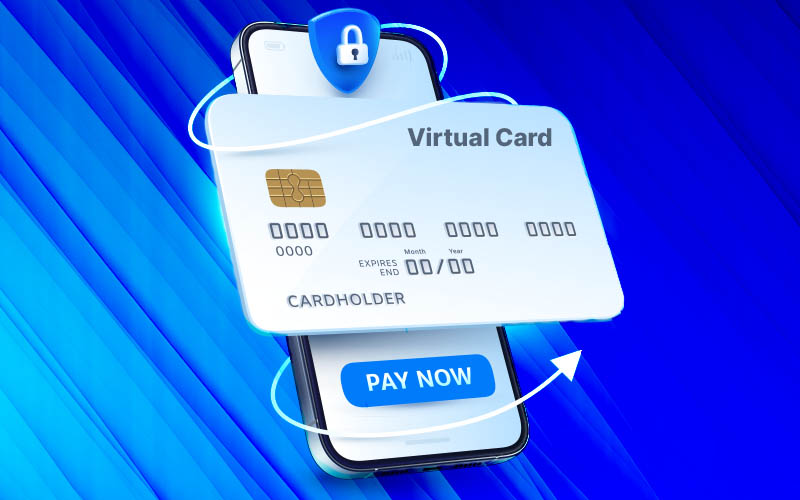In recent years, the digital landscape has rapidly evolved, and with it, so have the methods we use to manage our finances. The introduction of virtual credit cards has revolutionized how we shop, how we pay, and how we protect our financial data. Once seen as a niche payment solution, virtual credit cards have now become mainstream, offering consumers a more secure, flexible, and convenient way to handle online transactions. This article will explore the versatility of virtual credit cards, explaining what they are, how they work, their benefits, and why they have become an indispensable tool for modern consumers.
Whether you’re a frequent online shopper, someone who values financial security, or just someone looking to manage your spending more effectively, understanding the full potential of virtual credit cards is essential. This post will cover everything you need to know about virtual credit cards and how they are transforming the way we handle money in the digital age.
What Are Virtual Credit Cards?
A virtual credit card is a temporary, digital card that exists purely for the purpose of completing online or remote transactions. Unlike traditional plastic credit cards, a virtual card doesn’t have a physical form. Instead, it is generated by a financial institution or credit card provider, often via an app or website, and issued with a unique card number, expiration date, and CVV code. These details can be used in exactly the same way as a physical card for online purchases, but with one significant difference: virtual cards are often designed to be short-term or limited-use, adding an additional layer of security to your financial transactions.
How Do Virtual Credit Cards Work?
The process of using a virtual credit card is straightforward and user-friendly. You start by signing up with a bank or financial institution that offers virtual credit cards. Once registered, you can easily generate a virtual card number, which can be used for online purchases or recurring subscriptions. Here’s how they typically work:
- Generating the Card: Once you’ve logged into your online banking platform or mobile app, you can generate a virtual credit card. This card will be linked to your primary bank account or credit card, but it will have a unique number, different from your main account’s number. The card will also have a valid expiration date and CVV, just like a physical credit card.
- Making Purchases: To make an online purchase, you simply input the details of your virtual credit card (card number, expiration date, and CVV) in the payment section of the checkout page.
- Security Features: Many virtual cards are designed to be temporary. Once a transaction is completed, the card may automatically expire, preventing it from being used again. In some cases, users can set expiration dates themselves or generate new cards for each transaction, ensuring that even if the card information is compromised, it won’t lead to further unauthorized transactions.
- Integration with Bank Accounts: Virtual credit cards are usually tied to a user’s main credit card or bank account. They allow the user to control their spending by setting specific limits, such as the maximum transaction amount. Some virtual cards allow multiple uses, while others are set up for single-use only.
Features of Virtual Credit Cards
Virtual credit cards come with a variety of features that make them more versatile and secure compared to traditional payment methods. Some key features include:
- Single-Use or Multi-Use Options: Virtual credit cards can either be single-use, which are deactivated after one transaction, or multi-use, which allow for repeated transactions up to a preset limit. This provides flexibility, especially for people who regularly make online purchases.
- Enhanced Security: Virtual cards are designed to minimize fraud risks. Since the card number is unique and temporary, it’s much harder for hackers to use it maliciously. Even if someone steals the details, they won’t be able to use the card again or access your main bank account.
- Customizable Spending Limits: Virtual cards allow users to set specific spending limits. This could be particularly beneficial for managing budgets, paying for subscriptions, or limiting the amount spent on certain purchases.
- No Physical Card: There’s no need to carry a physical card around, reducing the risk of losing it or having it stolen. With virtual cards, all your payment details are stored securely in your mobile app or online banking platform.
- Increased Privacy: Many virtual credit cards offer enhanced privacy protection. The unique number used for each transaction ensures that your primary card details are not exposed during purchases. This is particularly useful when shopping on websites or with merchants you don’t fully trust.
The Benefits of Using Virtual Credit Cards
The primary reason many consumers turn to virtual credit cards is for enhanced security, but they offer a wide array of benefits beyond just that. Here are some of the key advantages:
Enhanced Security and Fraud Protection
Virtual credit cards provide an extra layer of security when making online purchases. By using a unique number for each transaction, the risk of fraud is greatly reduced. Even if a virtual card number is compromised, the thief cannot use it again. This offers peace of mind when purchasing from lesser-known websites, especially when the transaction involves sensitive information.
Additionally, many virtual card providers offer real-time transaction alerts, so you can immediately detect any suspicious activity. If you notice anything unusual, you can deactivate the card instantly. In comparison, traditional credit card fraud detection often occurs after the fact, sometimes leading to significant delays in resolving issues.
Convenient for Recurring Subscriptions
Virtual credit cards are ideal for managing subscriptions. Whether it’s for streaming services, software, or other regular payments, you can generate a virtual card specifically for each service. This allows you to set the card’s expiration date to match the subscription period, preventing any unwanted charges once your subscription expires.
Moreover, by using a virtual card for each subscription, you avoid the risk of one service unintentionally charging you after a free trial ends or when your payment method changes. You’ll have full control over how long the card remains active and the maximum amount that can be charged.
Budget Control
One of the most practical benefits of virtual credit cards is the ability to set spending limits. When using a virtual card, you can customize the amount available for each transaction, which is a great way to stick to a budget. This is especially useful for online shopping, as it ensures you don’t overspend or accidentally make unnecessary purchases.
For example, if you’re using a virtual card for a one-time purchase, you can set the spending limit to exactly the amount you want to spend. If the card is linked to your bank account, you can also set a maximum balance that the virtual card can access, preventing you from exceeding your financial limits.
Flexibility and Convenience
Virtual credit cards make online shopping faster and more convenient. You don’t need to carry a physical card around, and you can make purchases anytime, anywhere. Whether you’re on your computer, tablet, or phone, your virtual credit card details are always at your fingertips. Plus, virtual cards are typically accepted anywhere credit cards are, so you won’t face any limitations on where you can shop.
Since the cards are generated instantly, you don’t need to wait for a physical card to arrive in the mail. For anyone who needs a temporary or single-use card, this immediate availability is a game-changer.
Privacy and Anonymity
Using a virtual credit card also increases your privacy when making online purchases. By not using your main credit card details, you reduce the chances of exposing sensitive information to merchants, reducing the risk of identity theft. This is particularly important when shopping on unfamiliar websites or engaging in online transactions that require providing payment details.
Protection from Data Breaches
In today’s world, data breaches have become an all-too-common occurrence. With virtual cards, the details of your primary credit card are never exposed, protecting you from the fallout of a breach. If a merchant is hacked and your virtual card details are compromised, the worst-case scenario is that the fraudster won’t be able to access your main account.
This level of protection is invaluable in a time when data breaches can lead to serious financial consequences.
How to Get a Virtual Credit Card
Obtaining a virtual credit card is a relatively simple process, and many major banks and financial institutions now offer this service to their customers. Here’s how you can get one:
Step 1: Choose a Provider
Many financial institutions and fintech companies now provide virtual credit card services. Some of the most popular providers include:
- Revolut: This digital bank offers a wide range of financial services, including virtual credit cards, which can be used for secure online payments and purchases.
- Privacy.com: A specialized service that allows you to create virtual credit cards with customizable spending limits. It’s particularly popular for those who prioritize privacy and security.
- Capital One: Offers virtual credit card numbers to its customers, providing an easy and secure way to shop online.
- American Express: Provides a virtual card service for its cardholders, allowing them to create temporary cards for online transactions.
Step 2: Sign Up and Generate Your Card
Once you’ve chosen a provider, sign up for their virtual credit card service. Depending on the provider, you may need to link your bank account or a physical credit card. After linking your account, you can generate a virtual card number immediately.
Step 3: Set Preferences
Many providers allow you to set preferences for your virtual card. You can specify whether it’s a one-time use or if it can be used multiple times, set spending limits, and decide how long the card will remain active.
Step 4: Use Your Virtual Card
Once the card is generated, you can use it just like a physical credit card for online purchases. Simply input the card’s details during checkout, and your payment will be processed securely.
Virtual Credit Cards and Online Security: How They Protect You
Encryption and Tokenization
Many virtual card providers use encryption and tokenization technologies to ensure the safety of your card details. This means that the card number is converted into a code, making it impossible for anyone to access your actual card number. Even if hackers intercept the data, it will be unreadable and useless.
Fraud Detection and Alerts
Real-time fraud detection is a key feature of virtual credit cards. Many providers offer transaction alerts that notify you whenever a purchase is made. This allows you to monitor your spending and quickly spot any fraudulent activity.
Data Masking
Data masking is another technique used by virtual card providers to protect your information. When making a purchase, the virtual card details are masked or anonymized, ensuring that your personal financial data is never exposed.
The Future of Virtual Credit Cards
The future of virtual credit cards is bright. As digital payment solutions continue to evolve, we can expect to see even more widespread adoption of virtual cards, along with new features and functionalities. Integration with digital wallets like Apple Pay and Google Pay will make using virtual cards even more convenient, while advances in security technologies will further protect consumers from fraud.
In conclusion, virtual credit cards are transforming how we manage our financial transactions. They provide security, privacy, and control, making them an essential tool for anyone who wants to shop online safely, stay within their budget, and protect their personal information. As virtual cards become more widely used, they are sure to play a pivotal role in the future of digital payments.

